Sheepshead Minnow, Cyprinodon variegatus
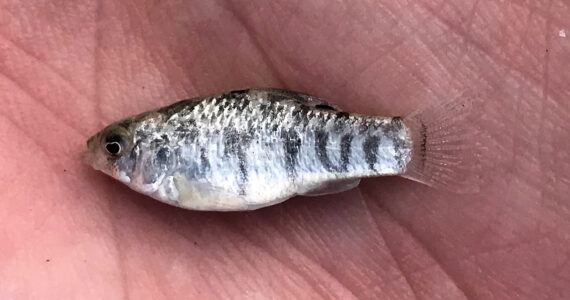 Sheepshead Minnow, Cyprinodon variegatus. Fish caught from the San Antonio River, San Antonio, Texas. September 2018. Length: 3.2 cm (1.3 inches). Catch, photograph and identification courtesy of Luke Ovgard, Klamath Falls, Oregon.
Sheepshead Minnow, Cyprinodon variegatus. Fish caught from the San Antonio River, San Antonio, Texas. September 2018. Length: 3.2 cm (1.3 inches). Catch, photograph and identification courtesy of Luke Ovgard, Klamath Falls, Oregon.
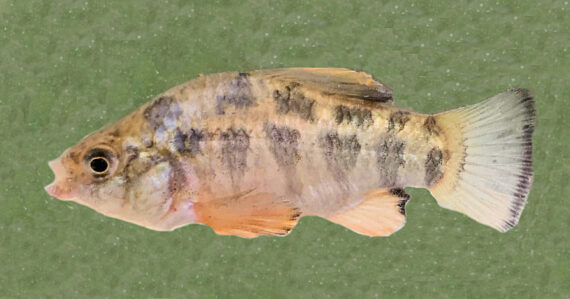
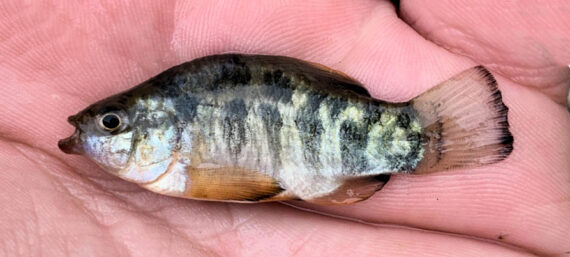 Sheepshead Minnow, Cyprinodon variegatus. Fish caught from a coastal stream of Long Island, New York, October 2021. Length: 3.8 cm (1.5 inches). Catch, photographs and identifications courtesy of James Lafontaine, Long Island, New York.
Sheepshead Minnow, Cyprinodon variegatus. Fish caught from a coastal stream of Long Island, New York, October 2021. Length: 3.8 cm (1.5 inches). Catch, photographs and identifications courtesy of James Lafontaine, Long Island, New York.
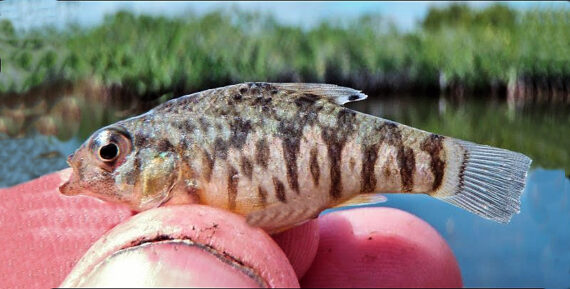 Sheepshead Minnow, Cyprinodon variegatus. Fish caught from coastal waters off Cedar Key, Florida, March 2018. Length: 4.8 cm (1.9 inches). Catch, photograph, and identification courtesy of Josh Leisen (joshadventures.com), Gaylord, Michigan.
Sheepshead Minnow, Cyprinodon variegatus. Fish caught from coastal waters off Cedar Key, Florida, March 2018. Length: 4.8 cm (1.9 inches). Catch, photograph, and identification courtesy of Josh Leisen (joshadventures.com), Gaylord, Michigan.
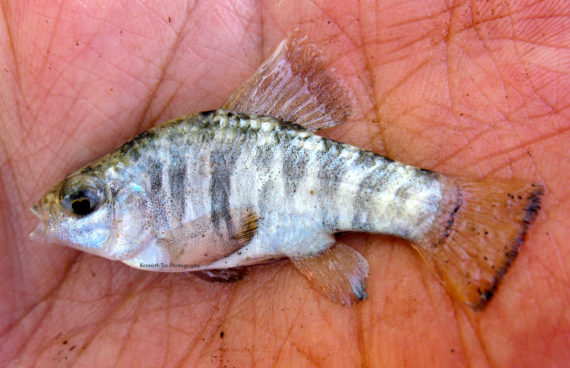 Sheepshead Minnow, Cyprinodon variegatus, Non-Breeding Male. Fish caught from a brackish pond near Hollywood, Florida, April 2015. Length: 5.1 cm (2.0 inches). Catch, photograph, and identification courtesy of Kenneth Tse, Toronto, Ontario, Canada.
Sheepshead Minnow, Cyprinodon variegatus, Non-Breeding Male. Fish caught from a brackish pond near Hollywood, Florida, April 2015. Length: 5.1 cm (2.0 inches). Catch, photograph, and identification courtesy of Kenneth Tse, Toronto, Ontario, Canada.
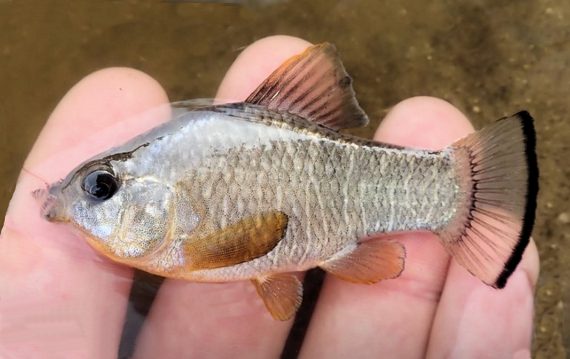 Sheepshead Minnow, Cyprinodon variegatus, Non-Breeding Male. Fish caught from coastal waters off Cedar Key, Florida, March 2018. Length: 5.3 cm (2.1 inches). Catch, photography and identification courtesy of Ben Cantrell, San Diego, California.
Sheepshead Minnow, Cyprinodon variegatus, Non-Breeding Male. Fish caught from coastal waters off Cedar Key, Florida, March 2018. Length: 5.3 cm (2.1 inches). Catch, photography and identification courtesy of Ben Cantrell, San Diego, California.
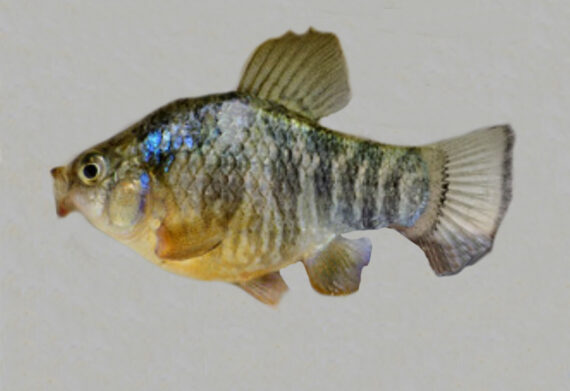 Sheepshead Minnow, Cyprinodon variegatus, Non-Breeding Male. Fish caught from coastal waters off Cedar Key, Florida, March 2018. Length: 5.3 cm (2.1 inches). Catch, photograph and identification courtesy of Eli (obsessiveangling.wordpress.com).
Sheepshead Minnow, Cyprinodon variegatus, Non-Breeding Male. Fish caught from coastal waters off Cedar Key, Florida, March 2018. Length: 5.3 cm (2.1 inches). Catch, photograph and identification courtesy of Eli (obsessiveangling.wordpress.com).
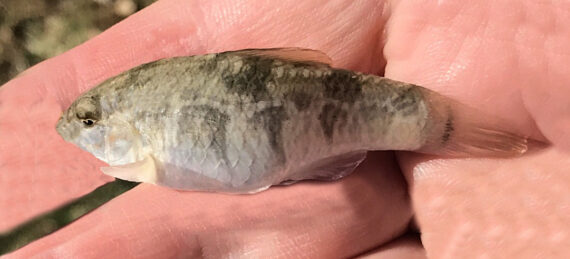 Sheepshead Minnow, Cyprinodon variegatus. Fish caught from within McKay Bay, Tampa Florida, March 2017. Length: 6.2 cm (2.4 inches). Catch, photography and identification courtesy of Ryan Crutchfield, Tampa, Florida.
Sheepshead Minnow, Cyprinodon variegatus. Fish caught from within McKay Bay, Tampa Florida, March 2017. Length: 6.2 cm (2.4 inches). Catch, photography and identification courtesy of Ryan Crutchfield, Tampa, Florida.
The Sheepshead Minnow, Cyprinodon variegatus, is a member of the Pupfish or Cyprinodontidae Family, that is also known as the Sheepshead Pupfish and in Mexico as bolin petota. The family members are known collectively as cachorritos in Mexico. There are one hundred thirty-six species placed in nine genera in the Cyprinodontidae Family. Globally, there are thirty-six species in the genus Cyprinodon, of which two are found in Mexican waters of the Atlantic Ocean.
The Sheepshead Minnow has a deep and laterally compressed bodies with an arched back; the body depth in mature adults is almost 50% of standard length. They are dimorphic with males being larger and having deeper bodies as well as larger anal, dorsal, and pectoral fins than females. Males can be identified by a black band at the base of their caudal fin. Males become highly colored during the breeding season, being olive with steel-blue and green tinges from their nape to their dorsal fin, having a series of subtle dark bars on their flanks, and transitioning from yellow to orange ventrally. The anal and pelvic fins of males are yellow with a dark margin; their caudal fin has a dark margin; and their pectoral fins are orange with a dark margin. Females are lighter in color, being olive, brown, brassy, or orange dorsally, having 9 to 14 bars on their sides that alternate with 7 or 8 lighter bars, and being yellowish-white ventrally. The fins of females are clear with the exception of an ocellus at the rear end of their dorsal fin. Both sexes have a small head that is flat on top, a short snout, and a small oblique terminal mouth that reaches the front margin of the eyes and is equipped with large wedge-shaped teeth with three cusps. Their anal fin has 8 to 10 rays and is inserted at the rear margin of the dorsal fin; their caudal fin has a thick base and is square; their single dorsal fin has 9 to 11 rays, found mid-body and has a short base; and, their pectoral fins are large and extend past the origin of the small pelvic fins. They have 18 to 23 gill rakers. They are covered with large circular scales. They do not have a lateral line.
The Sheepshead Minnow is an euryhaline species found in both salt marshes and estuaries as well as in fresh water lagoons in and around heavily vegetated areas that lack wave action; they are found over sandy and muddy bottoms at depths up to 2 m (6 feet). They are non-migratory and rarely venture far from the coast. They grow to a maximum of 9.3 cm (3.7 inches) in length and have the ability to survive drastic local conditions including high salinities, low oxygen, and water with elevated temperatures. They travel in schools and are omnivores consuming both animal and vegetable matter including detritus, small fish, microalgae, mosquitoes, crustacean larvae, and other small invertebrates. They exhibit aggressive behavior against intruders and can kill fish larger than them for territory protection and for food. They are preyed upon by the Atlantic Croaker, the Spotted Seatrout, the Red Drum, several sea birds, and various turtles, and are considered an important component of the coast food chain. They are known to bury themselves in the substrate to avoid predation and to hibernate during cold water episodes. During the breeding season, males become fiercely aggressive, highly territorial, and compete for females. Reproduction is oviparous with the release of multiple small batches of sticky eggs on a weekly basis that are fertilized externally before sinking to the bottom and attaching themselves to the substrate; eggs hatch in 5 to 6 days. Their lifespan is unknown.
The Sheepshead Minnow is a resident of Mexican waters of the Atlantic Ocean but has a very limited distribution being found in all brackish waters environments along the East Coast of the Gulf of Mexico.
The Sheepshead Minnow is fairly similar to, and can be confused with, the Yucatán Pupfish, Cyprinodon artifrons (only found in waters of the Yucatán Peninsula).
From a conservation perspective the Sheepshead Minnow is currently considered to be of Least Concern with stable, widely distributed populations. Populations estimates project in excess of one million individuals. They have been widely introduced within the southern United States with devastating results as they have hybridized and eradicated many native endangered pupfish. The Sheepshead Minnow is used extensively by the aquarium trade as they are easy to maintain and breed in captivity. They are also used as bait fish by recreational anglers, as forage fish in aquaculture, and to measure pollution levels in various bodies of water by governmental agencies.